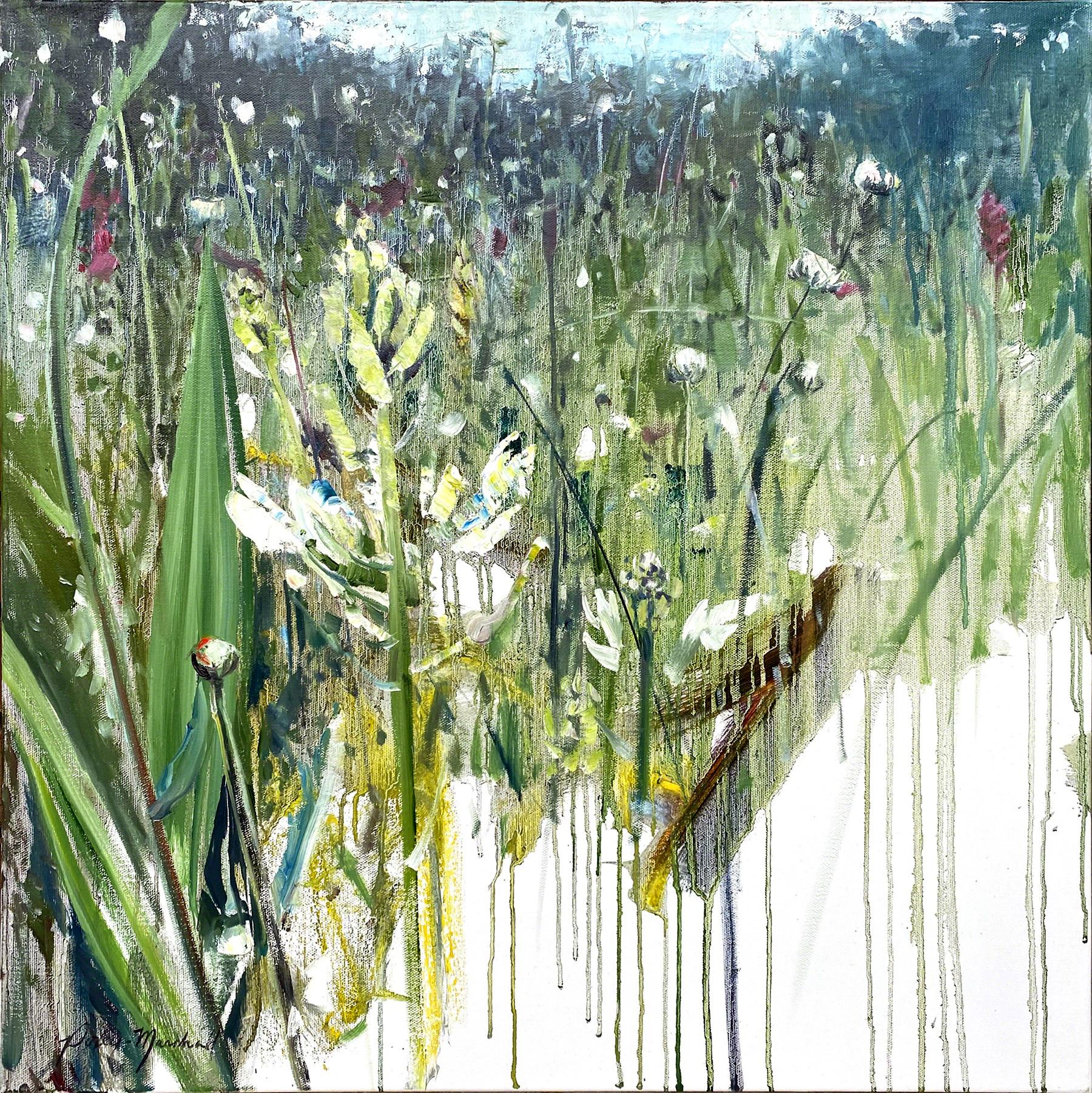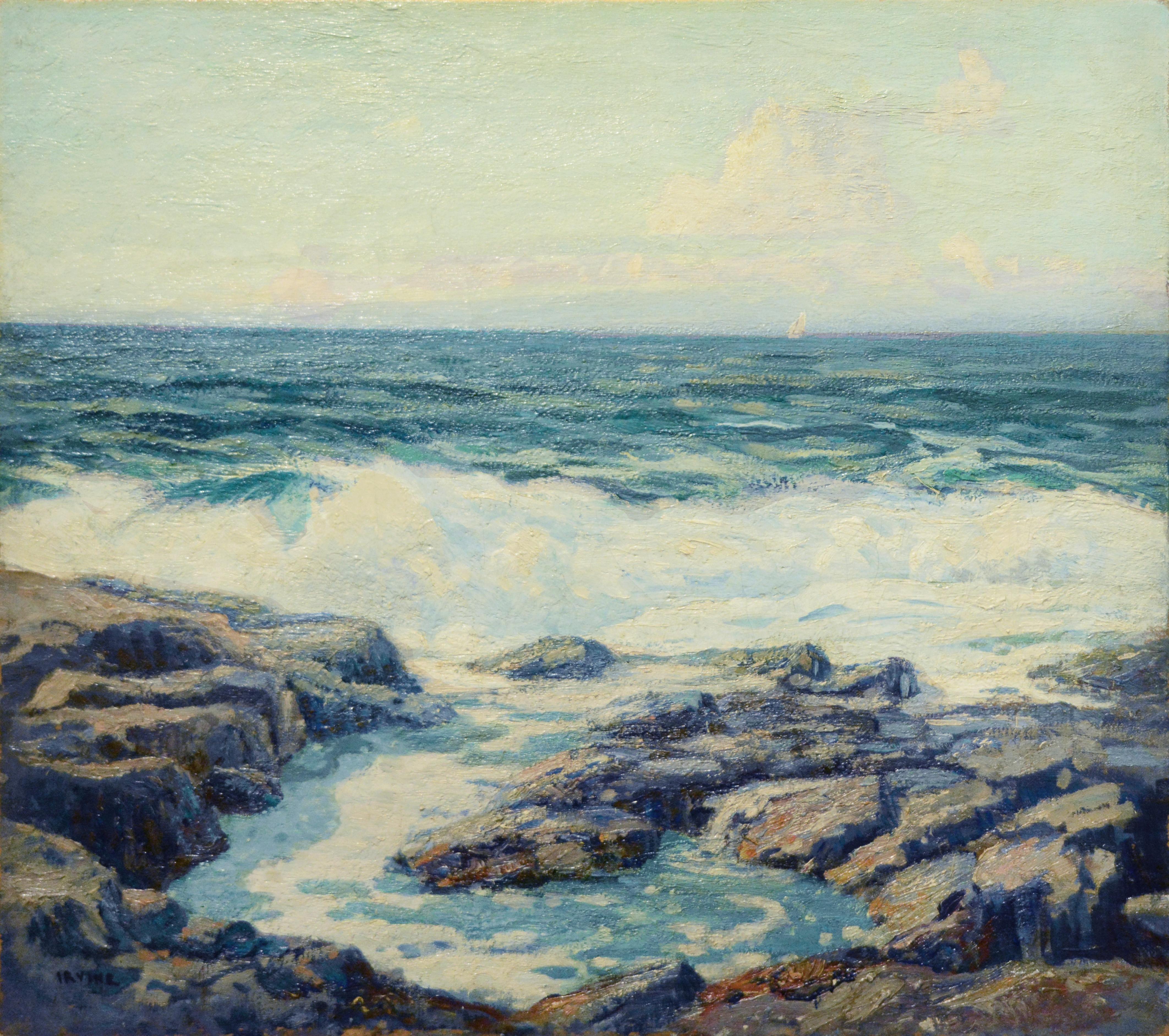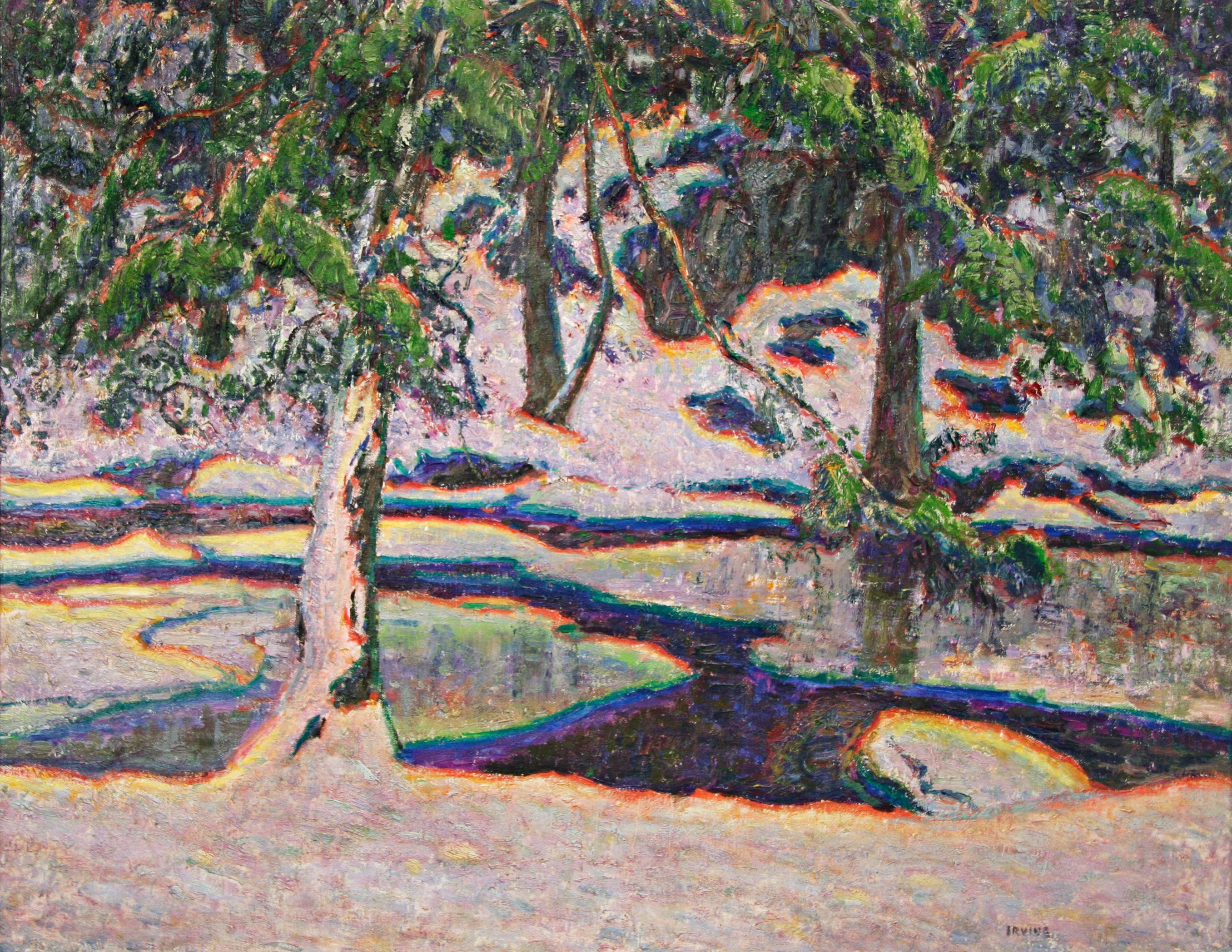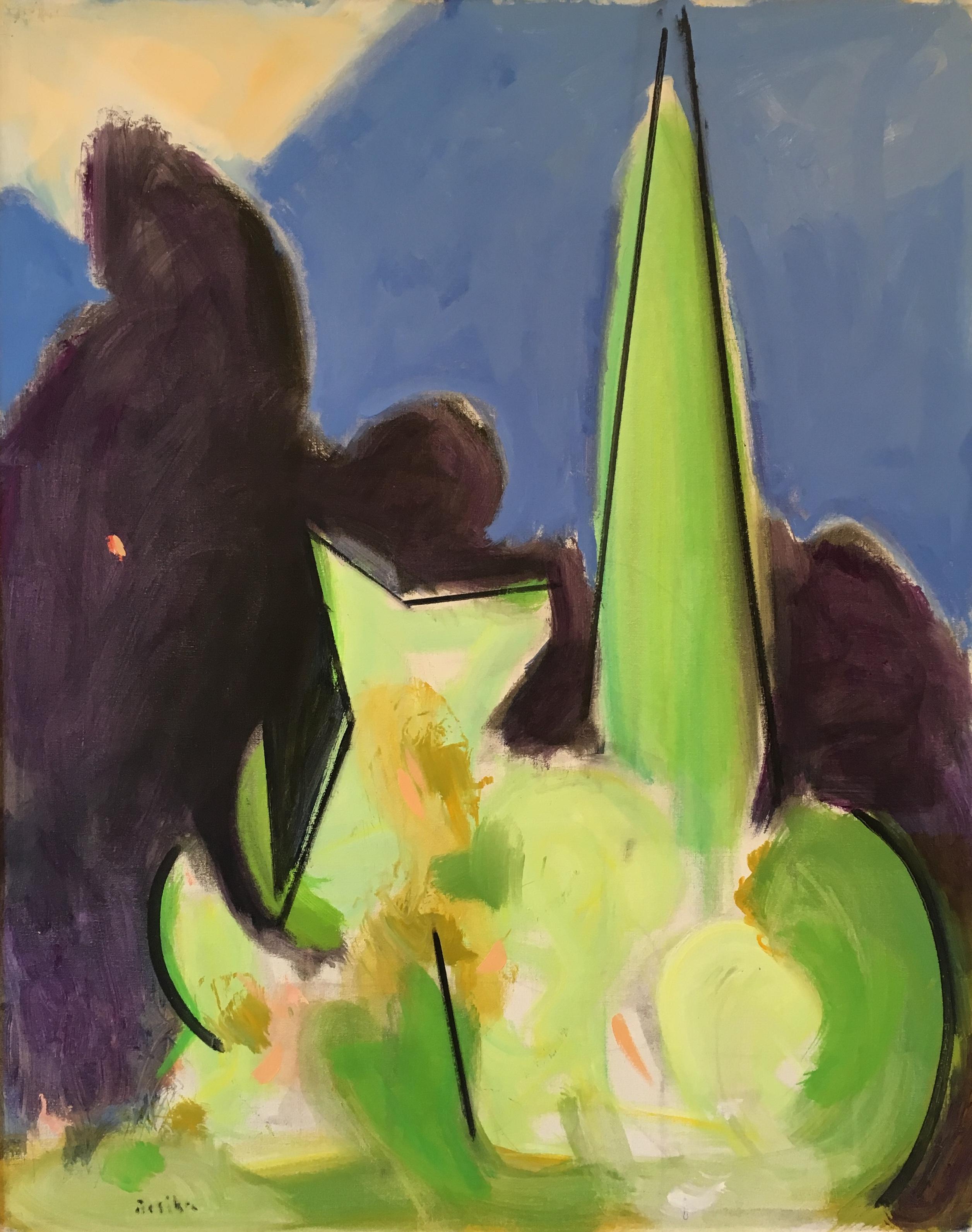Items Similar to "Barns and Silos in New Jersey" Wolf Kahn, Landscape, Abstract Impressionist
Want more images or videos?
Request additional images or videos from the seller
1 of 16
Wolf Kahn"Barns and Silos in New Jersey" Wolf Kahn, Landscape, Abstract Impressionist1985
1985
About the Item
Wolf Kahn
Barns and Silos in New Jersey, 1985
Signed lower center
Oil on canvas
28 x 34 inches
An important member of the second generation New York School, Wolf Kahn is renowned for his luminous, richly colored landscapes. Focusing on such thematic imagery as the tended fields, houses and sturdy barns of New England, Kahn's work represents a masterful synthesis of illusionistic representation and abstraction.
Kahn was born in Stuttgart, Germany, in 1927. As a boy, he studied painting and drawing in Frankfurt. In 1939 his family separated by the Nazi upheaval, Kahn was sent to Cambridge, England, with other refugee children. One year later he arrived in New York City, where he was united with his father, a noted musician. Kahn continued his education at the New York High School of Music and Art, graduating in 1945. During 1946 after a brief period of service in the Navy, he worked under Stuart Davis at the New School for Social Research. From 1947 until 1949, Kahn attended Hans Hofmann's School of Fine Art in New York. He also spent a summer as Hofmann's studio assistant in Provincetown.
In 1950 Kahn enrolled at the University of Chicago, receiving his bachelor's degree a year later. After a period of traveling across the continent and working in Oregon as a lumberjack, he returned to New York and resumed painting. In 1956, along with several other of Hofmann's former students, he helped found the Hansa Gallery, one of the first artists' co-operative loft galleries. During these years, Kahn was one of several young artists, including Elaine de Kooning and Robert De Niro, who were influenced by action painting but, at the same time, felt the need to reintroduce nature back into their art.
Kahn's early work consists of still lifes and figure studies, which show the influence of Hofmann's "push-pull" space as well as his gestural energy. However, Kahn's mature style revolves around the portrayal of un-peopled landscapes in which he combined an expressive chromaticism (inspired by Milton Avery and Mark Rothko) with an emphasis on the dynamics of light and atmosphere. Many describe him as a Luminist, carrying on the 19th century tradition but with a thoroughly modern sensibility. Kahn drew much of his subject matter from the landscape in and around his farm in Vermont, where he spent his summers.
Kahn had numerous solo exhibitions, organized by such institutions as the San Diego Museum of Art (1984, 1987), the Munson-Williams-Proctor Institute (1882), the Arts Club of Chicago (1981) and the Rhode Island School of Design Museum (1979). He was also the recipient of many awards and prized, including a Guggenheim Fellowship (1966-67).
- Creator:Wolf Kahn (1927, German)
- Creation Year:1985
- Dimensions:Height: 34 in (86.36 cm)Width: 40 in (101.6 cm)
- Medium:
- Movement & Style:
- Period:
- Condition:
- Gallery Location:New York, NY
- Reference Number:1stDibs: LU1841213711632
About the Seller
5.0
Platinum Seller
These expertly vetted sellers are 1stDibs' most experienced sellers and are rated highest by our customers.
Established in 2021
1stDibs seller since 2022
59 sales on 1stDibs
Typical response time: 1 hour
- ShippingRetrieving quote...Ships From: New York, NY
- Return PolicyA return for this item may be initiated within 3 days of delivery.
More From This SellerView All
- "Spring" Milton Derr, Bright Landscape, Boston Black ArtistLocated in New York, NYMilton Derr Spring, 1982 Signed lower right; titled and dated verso Oil on canvas 26 x 28 inches Milton Derr, also known as Milton Johnson, was a painter, illustrator and educator. Born in 1932 in Milwaukee, Wisconsin, Derr studied at the Layton School of Art, Milwaukee, the School of the Museum of Fine Arts, Boston, and the Independent Group of Painters and Sculptors, Tokyo, Japan. He been featured in many exhibitions, including several sponsored by Northeastern University’s African-American Master Artists in Residency Program, the Federal Reserve Bank of Boston, the Museum of the National Center of Afro-American Artists, the Boston Museum of Fine Arts, and the Studwasio Museum of Harlem. During the Korean War, he served in the United States Air Force. In 1964, Derr joined the faculty at the School of the Museum of Fine Arts. He also taught at Tufts University. Derr describes himself as a figurative painter whose style falls somewhere between expressionism and impressionism. He has been included among the black...Category
1980s Abstract Impressionist Landscape Paintings
MaterialsOil, Canvas
- "Behind Reeds" Wolf Kahn, Vermont Marsh Landscape with Trees and Barn, PastelsBy Wolf KahnLocated in New York, NYWolf Kahn Behind Reeds, 2004 Signed lower left Pastel on paper 7 x 9 inches Provenance: The artist Ameringer McEnery Yohe Gallery, New York Private Collection, Florida An important...Category
Early 2000s Abstract Impressionist Landscape Paintings
MaterialsPaper, Pastel
- "Purple Hills" Wolf Kahn, Vermont Meadow Landscape, PastelsBy Wolf KahnLocated in New York, NYWolf Kahn Purple Hills Pastel on paper 10 1/2 x 13 1/2 inches Provenance: Collection of Stafford Elias Christies New York, Interiors, December 13, 2017, Lot 343 Private Collection, ...Category
21st Century and Contemporary Abstract Impressionist Landscape Paintings
MaterialsPaper, Pastel
- "Dark Diagonal" Wolf Kahn, Vermont Landscape with Trees, PastelsBy Wolf KahnLocated in New York, NYWolf Kahn Dark Diagonal, 2012 Signed lower center Pastel on paper 9 x 12 inches An important member of the second generation New York School, Wolf Kahn is renowned for his luminous,...Category
2010s Abstract Impressionist Landscape Paintings
MaterialsPastel, Paper
- "Summer Studio" Wolf Kahn, Vermont Landscape, Abstract Impressionist, PastelsBy Wolf KahnLocated in New York, NYWolf Kahn Summer Studio, 2012 Signed lower center Pastel on paper 9 x 11 1/2 inches An important member of the second generation New York School, Wolf K...Category
2010s Abstract Impressionist Landscape Paintings
MaterialsPastel, Paper
- "Harvard vs Yale" Charles Green Shaw, Football, Ivy League Sports, AbstractBy Charles Green ShawLocated in New York, NYCharles Green Shaw Harvard vs. Yale, 1944 Signed and dated on the reverse Oil on canvasboard 9 x 12 inches Provenance: Harvey and Francois Rambach, New Jersey Private Collection, California Washburn Gallery, New York D. Wigmore Fine Art, New York Private Collection, New York Charles Green Shaw, born into a wealthy New York family, began painting when he was in his mid-thirties. A 1914 graduate of Yale, Shaw also completed a year of architectural studies at Columbia University. During the 1920s Shaw enjoyed a successful career as a freelance writer for The New Yorker, Smart Set and Vanity Fair, chronicling the life of the theater and café society. In addition to penning insightful articles, Shaw was a poet, novelist and journalist. In 1927 he began to take a serious interest in art and attended Thomas Hart Benton's class at the Art Students League briefly in New York. He also studied privately with George Luks, who became a good friend. Once he had dedicated himself to non-traditional painting, Shaw's writing ability made him a potent defender of abstract art. After initial study with Benton and Luks, Shaw continued his artistic education in Paris by visiting numerous museums and galleries. From 1930 to 1932 Shaw's paintings evolved from a style imitative of Cubism to one directly inspired by it, though simplified and more purely geometric. Returning to the United States in 1933, Shaw began a series of abstracted cityscapes of skyscrapers he called Manhattan Motifs which evolved into his most famous works, the shaped canvases he called Plastic Polygons. The 1930s were productive years for Shaw. He showed his paintings in numerous group exhibitions, both in New York and abroad, and was also given several one-man exhibitions. Shaw had his first one-man exhibition at the Valentine Dudensing Gallery in New York in 1934, which included 25 Manhattan Motif paintings and 8 abstract works. In the spring of 1935 Shaw was introduced to Albert Gallatin and George L.K. Morris. Gallatin was so impressed with Shaw's work, he broke a policy against solo exhibitions at his museum, the Gallery of Living Art, and offered Shaw an exhibition there. In the summer of 1935 Shaw traveled to Paris with Gallatin and Morris who provided introductions to many great painters. Shaw regularly spent time with John Ferren and Jean Hélion. The following year Gallatin organized an exhibition called Five Contemporary American Concretionists at the Reinhardt Gallery that included Shaw, Ferren, and Morris, Alexander Calder, and Charles Biederman...Category
1940s Abstract Geometric Landscape Paintings
MaterialsOil, Board
You May Also Like
- Light From AboveBy Downy Doxey MarshallLocated in Salt Lake City, UT"Light From Above" by Downy Doxey Marshall, oil on canvas, 36 X 36 inches (framed size: 38 x 38 inches), $5,500. "As a child I dreamt of having a pond in my backyard. The thoughts of floating in a glass bottom boat...Category
2010s Abstract Impressionist Landscape Paintings
MaterialsCanvas, Oil
- Meadow GossamerBy Downy Doxey MarshallLocated in Salt Lake City, UT"Meadow Gossamer" by Downy Doxey Marshall, oil on canvas, 24 x 24 inches (framed size: 26 x 26 inches), $3,500. "As a child I dreamt of having a pond in my backyard. The thoughts of floating in a glass bottom boat...Category
2010s Abstract Impressionist Landscape Paintings
MaterialsCanvas, Oil
- The Spring Waves, Monhegan IslandBy Wilson Henry IrvineLocated in Washington, DCFollowing two decades of successful impressionistic landscape painting, Wilson Henry Irvine became known for a new experimental style in the 1930s. In 1930, Irvine began making prismatic paintings—landscapes and still-lifes rendered as though seen through a glass prism. The effect accentuated the play of light on the edges of objects. Irvine remained committed to this style of prismatic painting throughout the 1930s, winning the best-picture award in 1934 for a picture of a life-sized nude at the annual exhibition of the Lyme Art...Category
1930s Abstract Impressionist Landscape Paintings
MaterialsCanvas, Oil
- Spring ThawBy Wilson Henry IrvineLocated in Washington, DCFollowing two decades of successful impressionistic landscape painting, Wilson Henry Irvine became known for a new experimental style in the 1930s. In 1930, Irvine began making prismatic paintings—landscapes and still-lifes rendered as though seen through a glass prism. The effect accentuated the play of light on the edges of objects. Irvine remained committed to this style of prismatic painting throughout the 1930s, winning the best-picture award in 1934 for a picture of a life-sized nude at the annual exhibition of the Lyme Art...Category
1930s Abstract Impressionist Landscape Paintings
MaterialsCanvas, Oil
- Pine and Spencer MountainBy Paul ResikaLocated in Provincetown, MAPaul Resika was born in New York City in 1928. He began taking painting lessons at age nine, greatly encouraged by his Russian émigré mother. At twelve years old, he began studying w...Category
21st Century and Contemporary Abstract Impressionist Landscape Paintings
MaterialsOil, Canvas
- The Lost City in the Andes (Machu PicchuLocated in Provincetown, MARoss Moffett remains a legendary Cape Cod artist. Moffett painted with an intensely personal focus, composing canvases that inevitably reflected the character of his native western A...Category
Early 20th Century Abstract Impressionist Landscape Paintings
MaterialsOil, Canvas





